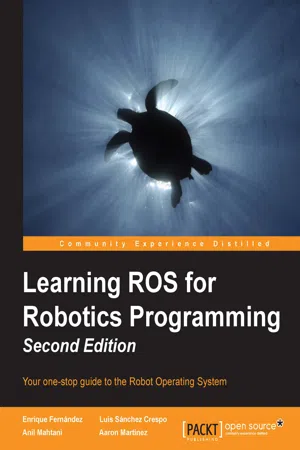
Learning ROS for Robotics Programming - Second Edition
Enrique Fernandez, Luis Sanchez Crespo, Anil Mahtani, Aaron Martinez, Luis Sanchez Crespo, Anil Mahtani
- 458 páginas
- English
- ePUB (apto para móviles)
- Disponible en iOS y Android
Learning ROS for Robotics Programming - Second Edition
Enrique Fernandez, Luis Sanchez Crespo, Anil Mahtani, Aaron Martinez, Luis Sanchez Crespo, Anil Mahtani
Información del libro
Your one-stop guide to the Robot Operating SystemAbout This Book• Model your robot on a virtual world and learn how to simulate it• Create, visualize, and process Point Cloud information• Easy-to-follow, practical tutorials to program your own robotsIn DetailIf you have ever tried building a robot, then you know how cumbersome programming everything from scratch can be. This is where ROS comes into the picture. It is a collection of tools, libraries, and conventions that simplifies the robot building process. What's more, ROS encourages collaborative robotics software development, allowing you to connect with experts in various fields to collaborate and build upon each other's work.Packed full of examples, this book will help you understand the ROS framework to help you build your own robot applications in a simulated environment and share your knowledge with the large community supporting ROS.Starting at an introductory level, this book is a comprehensive guide to the fascinating world of robotics, covering sensor integration, modeling, simulation, computer vision, navigation algorithms, and more. You will then go on to explore concepts like topics, messages, and nodes. Next, you will learn how to make your robot see with HD cameras, or navigate obstacles with range sensors. Furthermore, thanks to the contributions of the vast ROS community, your robot will be able to navigate autonomously, and even recognize and interact with you in a matter of minutes.What's new in this updated edition? First and foremost, we are going to work with ROS Hydro this time around. You will learn how to create, visualize, and process Point Cloud information from different sensors. This edition will also show you how to control and plan motion of robotic arms with multiple joints using MoveIt! By the end of this book, you will have all the background you need to build your own robot and get started with ROS.What You Will Learn• Install a complete ROS Hydro system• Create ROS packages and metapackages, using and debugging them in real time• Build, handle, and debug ROS nodes• Design your 3D robot model and simulate it in a virtual environment within Gazebo• Give your robots the power of sight using cameras and calibrate and perform computer vision tasks with them• Generate and adapt the navigation stack to work with your robot• Integrate different sensors like Range Laser, Arduino, and Kinect with your robot• Visualize and process Point Cloud information from different sensors• Control and plan motion of robotic arms with multiple joints using MoveIt! Who This Book Is ForIf you are a robotic enthusiast who wants to learn how to build and program your own robots in an easy-to-develop, maintainable, and shareable way, this book is for you. In order to make the most of the book, you should have a C++ programming background, knowledge of GNU/Linux systems, and general skill in computer science. No previous background on ROS is required, as this book takes you from the ground up. It is also advisable to have some knowledge of version control systems, such as svn or git, which are often used by the community to share code.Style and approachThis book is an easy-to-follow guide that will help you find your way through the ROS framework. This book is packed with hands-on examples that will help you program your robot and give you complete solutions using ROS open source libraries and tools.